U-869 (5/5)
The Sinking of the U-869
by Harold Moyers
On the night of February 11, 1945, the U.S. Coast Guard-manned Howard D. Crow, a 306-foot long destroyer escort, was heading 143 degrees south, southeast out of Ambrose channel NYC Harbor. The ship had been underway for eight hours and had joined up with convoy CU 58 to serve as protection from German submarine attacks. The Nazis had just suffered the defeat of their final European land offensive in the Ardennes Forest (known commonly as the Battle of the Bulge). Allied forces were now nearly assured of victory. The United States homeland, untouched by bombings, and emerging as the world's great industrial power, was hailed as the "arsenal of democracy" this arsenal was transported across the Atlantic by ships like those of convoy CU 58.
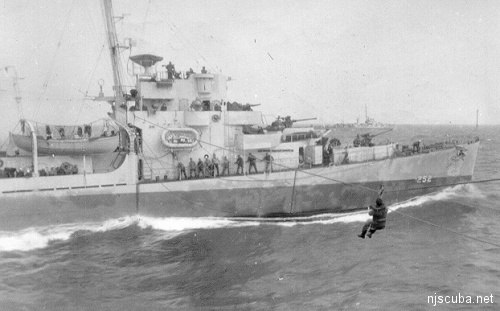
At that stage of the war, it was almost suicide to attack a defended convoy. The life expectancy of a U-Boat was two patrols. By 1945 an attacking sub could expect to sink only about one ship before detection. A few years earlier the situation was entirely different. German U-Boats were enjoying what they termed their "happy time". Allied convoys were being mauled by wolf packs of subs. These coordinated attacks, typically at night, were carried out over successive days over wide expanses of ocean. A mariner had reason to fear the approach of dusk and survival prospects were bleak in the cold, dark North Atlantic. Sailors on munitions ships or tankers carrying aviation fuel seldom knew what hit them. For them, the wait was worse than the end.
The war's turn was probably cold comfort for the men of CU 58. Ships were still being lost, although at a markedly reduced rate, and shipwrecked men were still freezing to death in the Atlantic. The men read the newspapers, they knew the war would soon be over; they had been running the U-Boat gauntlet in some cases for over five years. Merchant seamen suffered crew casualties higher than their U-Boat enemies. Many had to feel the stress of flipping the coin so many times with the ending of the war so near. The men of the Howard D. Crow didn't feel the end was as near for their wartime service. The invasions of Iwo Jima and Okinawa were still ahead and the allied "Europe first" strategy had left for the United States a Japanese enemy that was still very much alive. The men of the Crow and the other escorts knew that their reward for hard work in the Atlantic would be more hard work in the Pacific.
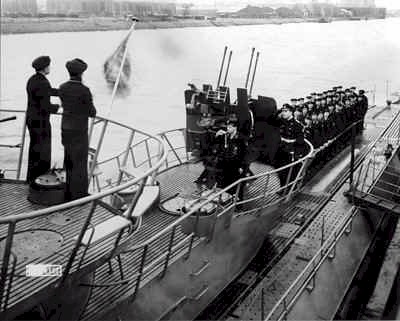
The crew of the German submarine U-869 sailed two months earlier with a different reality. They felt they were condemned men. This was their first patrol and there was no optimism that they would return to the quay greeted as heroes with marching bands and pretty girls admiring the victory pennants hanging from the conning tower. The U-Boats had abandoned their warm, lively French bases and their new bleak Norwegian bases were in shambles and constantly under attack. Victories were rare and celebratory pennants rarer. They had departed Kristanstand, Norway on December 8, 1944, for a point in the ocean several hundred miles south of Iceland, from there they would be directed via encoded radio message for a patrol destination. On December 29, 1944, U-Boat command radioed the submarine to patrol an area off the New Jersey Coast. The order was in turn rescinded when the U-869 radioed in her fuel supply. The young captain of the submarine, twenty-eight-year-old Helmut Neuerburg, had been extra cautious on his voyage to his detachment point. Neuerburg was on his first sub patrol ever and he no doubt was alarmed at the growing number of lost Commander's portraits that were covering the walls of the officers' clubs. Instead of taking his boat between Ireland and Iceland, Neuerburg had decided to travel the longer, but less patrolled route south of Greenland. This is what had diminished his fuel supply. U-Boat command rerouted him to the straights of Gibraltar where he would have more time to operate on patrol. They expected him to arrive on February 1, 1945.
Early evening February 11, 1945, was overcast and unseasonably warm in the mid-forty-degree range. The sea was calm with a slight swell from the east. Lt. John Nixon commanded the Crow. The anti-submarine warfare officer was Ensign I. G. "George" King who at 24 was just a few years older than some of the men under him. At 4:39 PM the sonar operator, Howard Denson, yelled out a strong contact. The contact was from sonar, a machine that produced a pinging noise and then analyzed a return echo. A good operator could distinguish a steel object from a hard sea bottom or a school of fish. Denson was a good operator, he was an original member or "plank owner" of the Crow's crew. He was well trained on his sonar equipment, as were most operators, the increasingly lopsided Battle of the Atlantic testified to that. His contact was so strong that ASW (Anti-Submarine Warfare) officer King ordered preparations for an immediate hedgehog attack without waiting for the captain's orders. A "hedgehog" was a special anti-submarine weapon mounted on the forward deck of the destroyer. It fired 24 missiles forward of the speeding vessel. The grouped missiles resembled a porcupine, or as the English say, "hedgehog". Each missile contained a 38 lb. warhead that only detonated on contact with a hard surface. The missiles landed on the water in an elongated elliptical pattern and rapidly sank until making contact, striking a sand bottom wouldn't set them off.
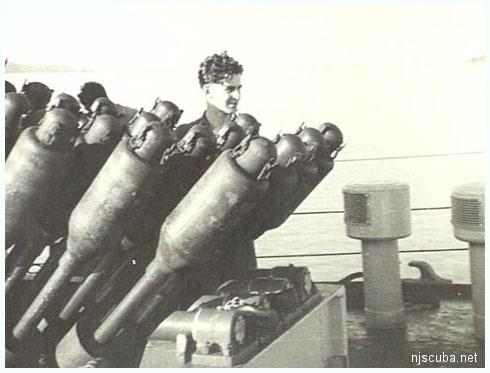
The destroyer approached the submerged contact at 4:53 PM, fourteen minutes after making contact, and fired her hedgehogs. Carpenters Mate Robert Quigly was below deck in the stem of the Crow. He knew nothing of the attack until the hedgehogs went off. At least one had detonated and the violence of the explosion was so great that he thought a torpedo had struck his own ship. He ran on deck only to witness an emerging oil slick on the water's surface. "What the hell's going on?" he asked gunners mate Ted Sieviec. Sieviec was his bunkmate and had also fired the hedgehogs. "We are attacking a submarine", he replied.
The Crow instantly called for help in the attack. The USS Koiner answered the call and turned northwest and headed the fifteen miles to the Crow at flank speed. A request also went out to CINCLANT (Commander and Chief Atlantic) for a hunter-killer group to pick up the attack. Hunter killer groups were specialists; they usually patrolled with a light aircraft carrier and contained several high-speed destroyers. Once they picked up the scent, they would stay on a target for hours, even days. The Crow and the Koiner requested the hunter group because they needed to rejoin the convoy as rapidly as possible. Their absence left the convoy vulnerable to attack from any other submarine that may be lurking nearby.
The Crow continued her attack as she waited for relief. At 5:17 PM four depth charges were dropped on the slowly moving contact. This resulted in air bubbles and more oil coming to the surface. Twenty-five minutes later three more depth charges were dropped. Again air bubbles and oil came to the surface. At 6:00 PM the Koiner arrived and investigated the sonar contact, which was now stationary on the bottom. As the Crow stood off, Lieutenant Commander Judson of the Koiner ordered an attack. In all, Judson ordered three attacks on the stationary target, each attack brought oil to the surface but no movement. He lowered a small boat over the side and Chief Ring investigated the dark water over the attack site. Ring soaked up oil on a rag and returned to the Koiner. Lieutenant Commander Judson ordered both vessels to return to convoy CU 58 and take up station. At 7:26 they were underway. Judson classified the contact non-sub. CINCLANT was notified that the hunter-killer group was no longer needed. The men of the Howard D. Crow were disappointed, errant depth charge attacks don't bring air bubbles and oil to the surface. They really felt they got one. In the escort report for CU 58 the event was written off as an attack on a wreck "submarine or otherwise" as the report stated. The attack occurred at an inexact point in the ocean roughly 39.30 North, 72.58 West. Sixty years after the attack, 92-year-old Charles Judson still recalls the night. "I thought I was attacking a wreck, it never moved the whole time I attacked it". Convoy CU 58 successfully crossed the Atlantic, with no losses.
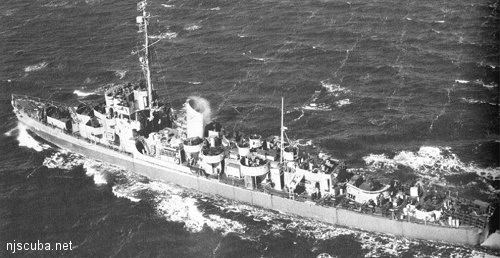
After the war, an exhaustive study was made to determine the fate of every German U-Boat. This was in part to determine who should be credited for which sinking. These after-war assessments took into account information from a variety of sources, namely the Eastern Sea Frontier Diary (our attack and activity records), as well as German sources. After war assessors noted the Howard D. Crow and Koiner attack but were inclined to believe in Lieutenant Commander Judson's analysis that the contact was a shipwreck lying on the bottom. German submarine command kept careful records: No U-Boats were operating off the New Jersey coast in February 1945. The boat commanded by Helmut Neuerburg, U-869, was presumed by the Germans to be sunk off Gibraltar. That was her patrol area and they failed to contact the vessel after repeated attempts. After war assessors had three attacks on contacts off Gibraltar in which to pin the success for the sinking. They settled on an attack on February 28, 1945, by USS Fowler and the French vessel L'Indiscret. The attack was assessed "B" (probable).
Forty-six years later, a group of hard-core Atlantic wreck divers made an incredible discovery, a Type IX German U-Boat. The wreck divers, spear-headed by John Chatterton, set to work identifying the sub. The story is well told in the New York Times Bestseller Shadow Divers. The divers, principally Chatterton, Richie Kohler, and John Yurga, had a problem that was the exact opposite that the after-war assessors had. The Jersey divers had a U-Boat without an attack whereas the assessors had an attack without a U-Boat. The two pieces of information were for some reason never linked even though the attack and the newly discovered submarine were near one another. Official Navy records said no attack in February '45, period. The Germans said no U-Boat was in that place at that time. The boat became a mystery sub and in his characteristic cleverness Chatterton dubbed the find the "U-Who".
In 1997, Chatterton was able to recover a tag solving the mystery as to the identity of the sub: she was the U-869. A careful analysis of Intelligence records indicated that the sub probably hadn't received the message to head to Gibraltar and obviously continued on her course to the New Jersey coast. As to why she sank? The original wreck diving trio came up with a circle run torpedo theory; the submarine fired a torpedo that doubled back on itself. At that stage of the war, U-Boats carried acoustic torpedoes that homed in on high-speed propeller noises. These weapons were primarily defensive, in theory, an escort racing in to attack a submarine could be destroyed by a homing torpedo. Despite initial reports of success, the weapon was in fact ineffective. A major reason the circle run theory was accepted was that British Navy experts who viewed underwater footage of the gaping hole in the submarines control room felt the damage was so massive that it had to be from a torpedo and not a depth charge. The other reason it was accepted is simply what else could have sunk it? Records never recorded an attack in that area. The circle-run torpedo theory has many flaws. Most notably that the U-Boat doesn't have a single wound but two wounds. She has a massive hole breaching her upper deck in the location of the aft torpedo room. The circle-run torpedo theorists have no explanation for this damage.
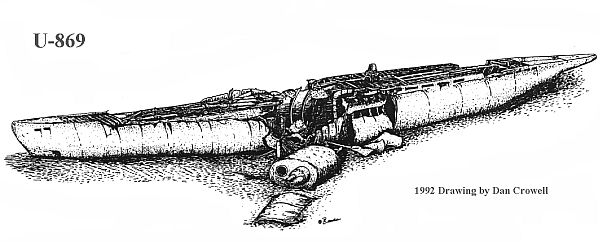
It's a fallacy to say that only a torpedo could have caused the U-869's damage. Clearly, a circular run torpedo wouldn't have made two large holes separated by a distance of 75'. The explosive warhead on a German T-5 acoustic torpedo was 604 Lbs. The explosive charge on a U.S. Mark 7 "ashcan" depth charge was 600 Lbs. The reason torpedoes typically produce more damage is because of the close proximity of the detonation. The depth charges on the Crow were set to explode at 200'. Several crewmembers remember that once while training off Corpus Christi, Texas they dropped depth charges set for 50'. The resulting concussion sprung leaks in the brand new warship and she had to go into dry dock for repairs. From that point on the charges were set to explode as deep as possible. The charges' depth fuses were set in 50' increments, 200' would have been a logical setting for the water depth at the attack site. The U-869 sits in 224' of water and the submarine's hull is 22.5' in diameter. That means it's possible that a depth charge with 600 lbs of explosives could detonate a foot off the pressure hull. This could explain the gaping hole in the U-869's control room as well as the aft torpedo room. Add to that damage forty-plus years of being struck by 10-ton clam dredges and fishing nets and you can begin to see that the damage is not unexplainable by depth charge. Those familiar with shipwrecks in this depth of water frequently see ships that have been reduced to a pile of rubble.
The known location of the U-869 is 4.5 miles from the reported position of the Crow and Koiner attack. Navigation of that era was an inexact science, 4.5 miles is remarkably close. If after the war assessors had known a German U-Boat was in that area in February, '45 they most certainly would have taken a closer look at the destroyers attack. The most interesting thing about the Crow / Koiner attack is the date, February 11, 1945. The U-Boat had reported its position on January 6, 1945, at 56.21 North, 26.45 West. At this point, she had traveled 2070 miles from Norway, or 69 miles per day. German U-Boat command expected her to arrive in her Gibraltar operation area on February 1, 1945. This was a distance of 1770 miles. This also equaled 69 miles per day. The U-Boat however never headed to Gibraltar she headed to a point off New Jersey, this distance was 2430 miles. If she averaged 69 miles per day it would have taken 35 days to reach the location in which she sank. That date would have been February 11, 1945; the exact date of the Crow / Koiner attack.
In light of this newly uncovered information, a new ending can be envisioned for the U-869. Arriving in her patrol area in the busy waters off New Jersey she soon detects the sounds of a convoy over her underwater listening hydrophones. Traveling below the surface, her diesel engines breathing through a snorkel tube, the U-869 tries to position herself for an approach on the unsuspecting CU 58. Suddenly alarm fills the boat, the hydrophone operator hears the sound of an approaching warship moving fast. The young captain takes her deep. A hedgehog detonation sends the crew into a panic as the U-Boat skids along the bottom. Not dead but badly wounded she tries to creep away; one hedgehog isn't always sufficient to destroy a 1,120-ton U-Boat. The submarine was moving very slowly along the bottom as the Crow came in for her depth charge run. It's impossible to know which damage occurred first, the aft torpedo room or the control room. Either would have been instantly and catastrophically fatal. Lieutenant Commander Judson was probably correct in his assessment that he was bombing a wreck: a wreck that was one hour and thirty-eight minutes old.
It's highly likely that the attack on February 11, 1945, was responsible for the sinking of the U-869. The attack most probably prevented the submarine from attacking a ship in convoy CU-58. It's time to give these aging heroes the recognition they deserve.
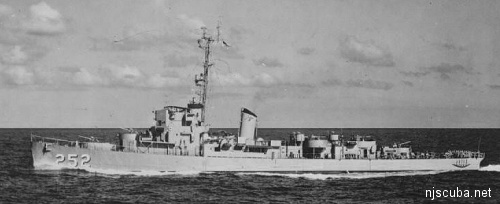
from USCG Historian's Office, June 2005
illustrations added by editor, njscuba,net
- Dan Crowell
- Richie Kohler
- John Chatterton

Questions or Inquiries?
Just want to say Hello? Sign the .